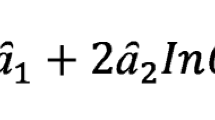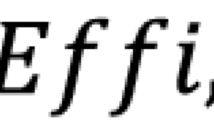Abstract
This paper studies the nexus between market power and business models in the banking industry. Business models are represented by non-interest income and non-deposit short-term funding share. We also examine the impact of bank business models on banking stability and performance. Using a sample comprising six ASEAN country banking sectors from 2002 to 2015, we find that banks with a strong capital base but lower net interest margin perform better in translating their market power into generating non-traditional income as alternative sources of revenues. Our findings also show that the implementation of the Basel 2 Accord encourages banks to create non-interest income from trading and derivatives activities as well as from other non-interest income. We also document that banks with higher market power tend to increase non-deposit short-term funding in their financing mix. In the evaluation of banking stability, our results suggest that banks with greater non-traditional income are associated with less overall banking risk. Moreover, non-traditional incomes also contribute to better bank performance.

Similar content being viewed by others
Notes
We include Islamic banks in the category of commercial banks due to the same business activities, although it should be noted that Islamic banks do not charge interest.
We agree with the suggestion from one of the reviewer to add foreign exchange (ER) variable as an additional variable on top of the existing country control variables considering that (i) banks’ short short-term borrowing consist not only from local currency, and (ii) the ASEAN financial crisis in late 1990 was stimulated by the devaluation of local currencies in Thailand and Indonesia and the spillover to its neighbors. We include this variable in the examination of the relationship between bank business models and banking stability and performance.
The term “deposit” in this study refer to traditional funding (current, saving, and time deposit accounts), while deposits from banks have a different characteristics compared to banks’ traditional funding. These type of deposits are made by other banks through the interbank market system.
The regression results of the Eurozone banking sectors with respect to the link between market power and bank business models is provided in “Appendix”.
References
Altunbas, Y., Manganelli, S. and Marques-Ibanez, D. (2011). Bank risk during the financial crisis: Do business models matter?, Eurosystem. 1394.
Amel, D., Barnes, C., Panetta, F., & Salleo, C. (2004). Consolidation and efficiency in the financial sector: A review of the international evidence. Journal of Banking & Finance, 28(10), 2493–2519.
ASEAN, S. (2015) ASEAN Economic Community Blueprint 2025.
Berger, A. N., Klapper, L. F., & Turk-Ariss, R. (2009). Bank competition and financial stability. Journal of Financial Services Research, 35(2), 99–118.
Boyd, J. H., Graham, S. L., & Hewitt, R. S. (1993). Bank holding company mergers nonbank financial firms: Effects on the risk of failure. Journal of Banking & Finance, 17, 43–63.
Calomiris, C. W. (1999). Building an incentive-compatible safety net. Journal of Banking & Finance, 23, 1499–1519.
Curi, C., Lozano-Vivas, A., & Zelenyuk, V. (2015). Foreign bank diversification and efficiency prior to and during the financial crisis: Does one business model fit all? Journal of Banking & Finance, 61, S22–S35.
Demirgüç-Kunt, A., & Huizinga, H. (2010). Bank activity and funding strategies: The impact on risk and returns. Journal of Financial Economics, 98(3), 626–650.
DeYoung, R., & Torna, G. (2013). Nontraditional banking activities and bank failures during the financial crisis. Journal of Financial Intermediation, 22(3), 397–421.
Elsas, R., Hackethal, A., & Holzhäuser, M. (2010). The anatomy of bank diversification. Journal of Banking & Finance, 34(6), 1274–1287.
Goodfriend, M. and King, R. G. (1988). Financial deregulation, monetary policy, and central banking, Federal Reserve Bank of Richmond.
Huang, R., & Ratnovski, L. (2011). The dark side of bank wholesale funding. Journal of Financial Intermediation, 20(2), 248–263.
Köhler, M. (2015). ‘Which banks are more risky? The impact of business models on bank stability. Journal of Financial Stability, 16, 195–212.
Mergaerts, F., & Vander Vennet, R. (2016). Business models and bank performance: A long-term perspective. Journal of Financial Stability, 22, 57–75.
Nguyen, M., Skully, M., & Perera, S. (2012a). Bank market power and revenue diversification: Evidence from selected ASEAN countries. Journal of Asian Economics, 23(6), 688–700.
Nguyen, M., Skully, M., & Perera, S. (2012b). Market power, revenue diversification and bank stability: Evidence from selected South Asian countries. Journal of International Financial Markets, Institutions & Money, 22(4), 897–912.
Roodman, D. (2009). How to do xtabond2: An introduction to difference and system GMM in Stata. Stata Journal, 9(1), 86–136.
Sealey, C. W. J., & Lindley, J. T. (1977). Inputs, outputs, and a theory of production and cost at depository financial institutions. The Journal of Finance, 32(4), 1251–1266.
Soedarmono, W., Machrouh, F., & Tarazi, A. (2011). Bank market power, economic growth and financial stability: Evidence from Asian banks. Journal of Asian Economics, 22(6), 460–470.
Turk Ariss, R. (2010). On the implications of market power in banking: Evidence from developing countries. Journal of Banking & Finance, 34(4), 765–775.
van Leuvensteijn, M., Bikker, J. A., van Rixtel, A. A. R. J. M., & Sorensen, C. K. (2011). A new approach to measuring competition in the loan markets of the euro area. Applied Economics, 43(23), 3155–3167.
Williams, B. (2016). The impact of non-interest income on bank risk in Australia. Journal of Banking & Finance, 73, 16–37.
Acknowledgements
This research has benefited from the financial support of the LPDP (Indonesia Endowment Fund for Education) and of Deloitte (Belgium and Luxembourg). The Authors would like to thank Cédric Heuchenne, Caroline Pommeranz, Bertram Steininger, and Didier Van Caillie, as well as the participants of the 2017 Luxembourg Doctoral Finance Workshop. We would like to thank the organizers of the EBES 25th Conference (Berlin 2018) for awarding us the best paper award. We also would like to thank Ahmed Faruk Aysan and all the participants of the EBES 25th Conference in Berlin. Finally, we thank to two EABR reviewers for their valuable feedback.
Author information
Authors and Affiliations
Corresponding author
Rights and permissions
About this article
Cite this article
Sudrajad, O.Y., Hübner, G. Empirical evidence on bank market power, business models, stability and performance in the emerging economies. Eurasian Bus Rev 9, 213–245 (2019). https://doi.org/10.1007/s40821-018-0112-1
Received:
Revised:
Accepted:
Published:
Issue Date:
DOI: https://doi.org/10.1007/s40821-018-0112-1




